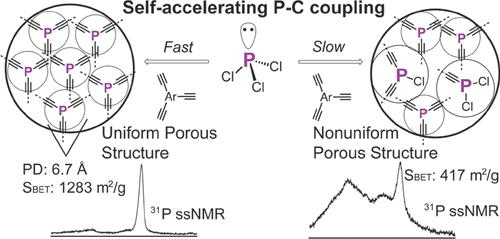当前位置:
X-MOL 学术
›
J. Am. Chem. Soc.
›
论文详情
Our official English website, www.x-mol.net, welcomes your
feedback! (Note: you will need to create a separate account there.)
Ultramicroporous Organophosphorus Polymers via Self-Accelerating P–C Coupling Reactions: Kinetic Effects on Crosslinking Environments and Porous Structures
Journal of the American Chemical Society ( IF 14.4 ) Pub Date : 2022-06-23 , DOI: 10.1021/jacs.2c03759 Zhikai Zhang 1 , Qing Wang 1 , Haiming Liu 1 , Tao Li 1 , Yi Ren 1
Journal of the American Chemical Society ( IF 14.4 ) Pub Date : 2022-06-23 , DOI: 10.1021/jacs.2c03759 Zhikai Zhang 1 , Qing Wang 1 , Haiming Liu 1 , Tao Li 1 , Yi Ren 1
Affiliation

|
Porous organic polymers (POPs) have drawn significant attention in diverse applications. However, factors affecting the heterogeneous polymerization and porosity of POPs are still not well understood. Herein, we report a new strategy to construct porous organophosphorus polymers (POPPs) with high surface areas (1283 m2/g) and ultramicroporous structures (0.67 nm). The strategy harnesses an efficient transition-metal-catalyzed phosphorus–carbon (P–C) coupling reaction at the trigonal pyramidal P-center, which is distinct from the typical carbon–carbon coupling reaction utilized in the synthesis of POPs. As the first kinetic study on the coupling reaction of POPs, we uncovered a self-accelerating reaction characteristic, which is controlled by the choice of bases and catalysts. The self-accelerating characteristic of the P–C coupling reaction is beneficial for the high surface area and uniform ultramicroporosity of POPPs. The direct crosslinking of the P-centers allows 31P solid-state (ss)NMR experiments to unambiguously reveal the crosslinking environments of POPPs. Leveraging on the kinetic studies and 31P ssNMR studies, we were able to reveal the kinetic effects of the P–C coupling reaction on both the crosslinking environments and the porous structures of POPPs. Furthermore, our studies show that the CO2 uptake capacity of POPPs is highly dependent on their porous structures. Overall, our studies paves the way to design new POPs with better controlled chemical and ultramicroporous structures, which have potential applications for CO2 capture and separation.
中文翻译:

通过自加速 P-C 偶联反应制备超微孔有机磷聚合物:对交联环境和多孔结构的动力学影响
多孔有机聚合物(POPs)在各种应用中引起了广泛关注。然而,影响持久性有机污染物非均相聚合和孔隙率的因素仍不清楚。在此,我们报告了一种构建具有高表面积(1283 m 2)的多孔有机磷聚合物(POPPs)的新策略。/g) 和超微孔结构 (0.67 nm)。该策略在三角锥体 P 中心利用有效的过渡金属催化的磷-碳 (P-C) 偶联反应,这与合成 POPs 中使用的典型碳-碳偶联反应不同。作为对 POPs 偶联反应的第一个动力学研究,我们发现了由碱和催化剂的选择控制的自加速反应特性。P-C偶联反应的自加速特性有利于POPPs的高表面积和均匀的超微孔率。P 中心的直接交联允许31 P 固态 (ss)NMR 实验明确揭示 POPP 的交联环境。利用动力学研究和31通过 P ssNMR 研究,我们能够揭示 P-C 偶联反应对 POPP 的交联环境和多孔结构的动力学影响。此外,我们的研究表明,POPPs 的 CO 2吸收能力高度依赖于它们的多孔结构。总体而言,我们的研究为设计具有更好控制化学和超微孔结构的新型持久性有机污染物铺平了道路,这些持久性有机污染物在 CO 2捕获和分离方面具有潜在应用。
更新日期:2022-06-23
中文翻译:

通过自加速 P-C 偶联反应制备超微孔有机磷聚合物:对交联环境和多孔结构的动力学影响
多孔有机聚合物(POPs)在各种应用中引起了广泛关注。然而,影响持久性有机污染物非均相聚合和孔隙率的因素仍不清楚。在此,我们报告了一种构建具有高表面积(1283 m 2)的多孔有机磷聚合物(POPPs)的新策略。/g) 和超微孔结构 (0.67 nm)。该策略在三角锥体 P 中心利用有效的过渡金属催化的磷-碳 (P-C) 偶联反应,这与合成 POPs 中使用的典型碳-碳偶联反应不同。作为对 POPs 偶联反应的第一个动力学研究,我们发现了由碱和催化剂的选择控制的自加速反应特性。P-C偶联反应的自加速特性有利于POPPs的高表面积和均匀的超微孔率。P 中心的直接交联允许31 P 固态 (ss)NMR 实验明确揭示 POPP 的交联环境。利用动力学研究和31通过 P ssNMR 研究,我们能够揭示 P-C 偶联反应对 POPP 的交联环境和多孔结构的动力学影响。此外,我们的研究表明,POPPs 的 CO 2吸收能力高度依赖于它们的多孔结构。总体而言,我们的研究为设计具有更好控制化学和超微孔结构的新型持久性有机污染物铺平了道路,这些持久性有机污染物在 CO 2捕获和分离方面具有潜在应用。











































 京公网安备 11010802027423号
京公网安备 11010802027423号